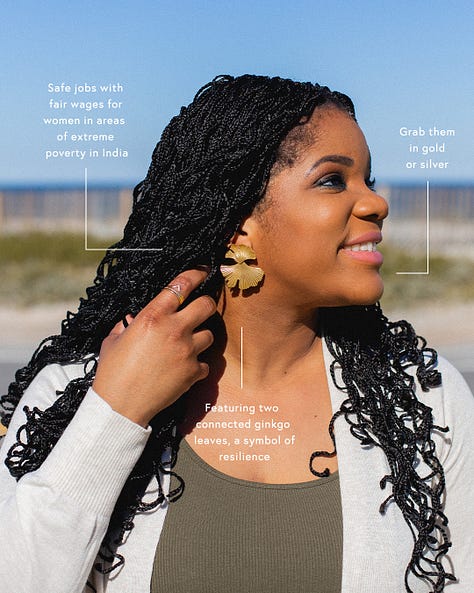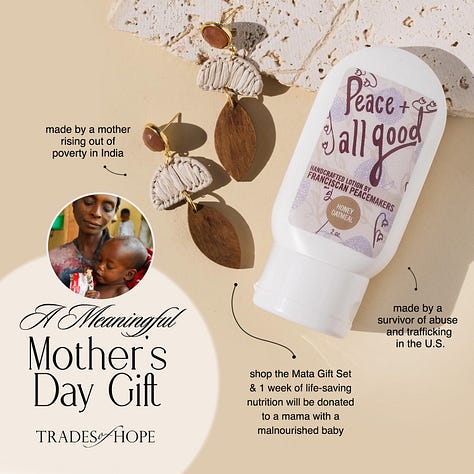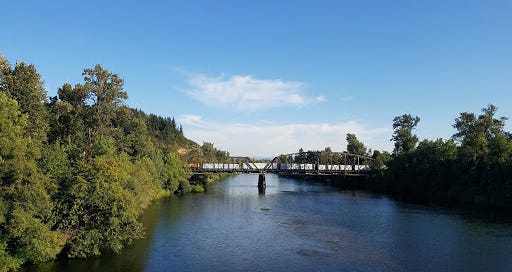Island Park Essay
The prompt is "write what you want to remember, write what you want to forget."
In Oregon’s Willamette (Wil-LAM-et) Valley, two rivers flow out of the mountains: the McKenzie River in the north and the Willamette River in the South. Nestled in that valley are two cities, and I spent half my childhood 40 miles away in Fall Creek. In Oregon, Fall Creek is known for its picturesque and quaint covered bridges, swimming holes, and campsites at the entrance to the national forest.
Eugene is a respectable college town, if a bit quirky. It has a reputation for too much tie-dye and weed, but it also boasts Oregon Track & Field, great coffee shops, the 5th Street Market, and green hills nestled with old Victorian-style homes where university professors live. I was born in Eugene, and I went to college there too. Most of my childhood memories are uncomplicated and happy, and they revolve around a forest kitchen, huckleberries, stealing raspberries from the bushes, private swimming holes and instructing the cows until I couldn’t see my hand in front of my face. There isn’t much I want to forget about my upbringing “outside of Eugene.”
While the McKenzie borders the metropolis, the Willamette gives riverfront access and parks to both cities as it meanders through, connects with the McKenzie outside Eugene, and heads north to meet the ocean. The freeway—northbound to another place I call home—not the river, divides Eugene from its smaller, edgier, more blue collar sister city, Springfield. The map reveals something else: Fall Creek and my grandma’s new home “in town” are firmly on the Springfield side of the interstate. Undeniably, so are most of my childhood memories.
A bend in the river creates a place where Eugene and Springfield are connected by a bridge. Day Island Park, in Springfield, is the setting of some of my most vivid memories with my dad. Every time I travel to Eugene, I cross the green truss bridge directly into the summer I was eleven.
When I catch sight of the tree-studded islands in the river and the green belt on the Springfield side that makes up the park, suddenly I can smell him. Faint smoke, incense, and trees. I smell a whole forest. My dad was a tree planter, and even when he wasn’t working, he smelled like fir trees, dirt and cigarettes. I am taking vitamin E capsules with carrot juice at a picnic table while his friends play hacky sack in the grass. He’s whistling. In my memories, he’s always whistling. I swam in the river at Island Park, sliding down a muddy bank into the murky water, when the worst thing he did was smoke a pack a day, when I could count on him to have money for beef jerky and ice cream from the corner deli, when I was happy but still sensed our future was murky.
When I want to remember, I choose the season—I don’t even know how long it was, maybe only a summer—when he was clean and sober, holding down a job and a room in a house in Springfield with his sober best friend, and I spent the day with him in the antique store where they worked, just a few blocks from Island Park. I think it must be this season that gave me the joy of the smell of old things, the weight of an antique brooch, the beauty in vintage colored mixing bowls and cut glasses. An artist was painting a mural on the side of the building all summer long; it featured a patchwork of images from Native American culture, and now this part of town is known for its murals. I don’t know if Main St. was safe, but it was cool, and I felt safe, allowed to wander in and out of the stores on my own, sometimes. I remember eating pork chops with applesauce, a meal my dad could make, with green salad and ranch dressing in parquet wooden bowls, and an orange creamsicle from the ice cream truck for dessert. And I remember knowing it wouldn’t last.
Another summer, same setting. I followed my dad across the bridge over Island Park after a festival by the river. Together with his girlfriend and her kids, we’d eaten slushies and French fries and listened to live music, and then that heavy Oregon rain fell and someone lost a flip flop on the bridge. Maybe it was me. I had a familiar, terrible feeling, but it was summer, and summer was for spending time with my dad.
That was the last summer before he fell.1
The sweet memories are as pleasant as a Pacific Northwest summer. But like grain in wood, or rivers through cities, there are harsh scars too. One year my dad took me camping deep in an evergreen forest. It was a wild adventure. We set up camp with some friends near a ravine at the end of a logging road, and I explored as far as I could go and still hear the piercing whistle of one of the other dads. It was tainted by worry, too, as my dad, who is allergic to bee stings, swelled up when horse fly bit him. That turned out ok. While we were gone, the forest on the acre of my grandparents’ property, where my dad and I had both played in as children, was destroyed. Enormous fir and cedar trees, which had been a refuge for me, my dad, and even before us, were dangerous for the house, and they had to be removed. That summer when we returned, I felt like a deer whose habitat had been devastated by a forest fire. A circle of rocks where I played campfire, the rooty stump that was my outdoor kitchen, the long, fallen logs between thehuckleberry bushes and the long hewn logs between them—destroyed. In their place, splintered cedar branches, logs, and so much dirt. The space was barren where it had been lush, exposed where it had been protected. When my dad was using, that’s how my childhood was too.
When my dad went to prison, we built a new kind of relationship, one we nurtured in plastic chairs and time limits. I’ll be here, he says when we say goodbye. He doesn’t have a choice. But when he had a choice, he wasn’t always there for me. Although it came with a heavy price, I can count on him to be there.
It took years to create a new kind of oasis in the yard after my grandparents had the trees removed. Eventually, flowers and shrubs were planted; a rock river wound through the new vegetation. Beautiful in a different way, and, importantly, safe.
That’s what I will remember.
Making Much of Myself
:: My 40th birthday party was featured on Verily Magazine. What a joy to relive this special day!
Making Much of Others
:: This beautiful essay about marriage and parenthood by Allie King moved me to tears.
:: I enjoyed this article last year and then again this year, but have never shared it. Palm Sunday, and Why the ‘Date’ Is So Significant
:: Why Cultural Intelligence Matters in the Divded World over at A Life Overseas
Making Memories
:: We didn’t plan a lot of things for my grandma’s third visit to Spain, but one highlight was Patones de Arriba, a medieval town with a unique history and delicious honey.
Making a Difference {shop fair trade}
Want fair-trade jewelry in your mailbox each month? I got the March earrings and love them. They came with a box and a beautiful sari drawstring bag that I used to hold cords while traveling. Buy once or subscribe for monthly Hope Mail surprises.





Making Food
Listen, I am not a food blogger. I am forever inspired by this post for the best [ever] butternut squash soup, which features a picture of a cut squash and nothing else, and even that photos is from unsplash! The recipe has loads of ingredients, takes a while, and results in, literally, the best butternut squash soup ever. It also reminds me of my friend Heather, who shared it with me. However, the recipe is easy to follow because it’s like having a friend in the kitchen with you, and it IS delicious and the soup is easy to make, so I always use it even though the post itself is not “aesthetically pleasing.”
That’s the vibe I bring to the Making Food portion of my newsletter.
My “recipes” are written for people who pretty much know their way around their kitchen, who are comfortable with making their own judgment calls when it comes to measuring and substituting. Even though it is always a good idea to do amise en place, I cook in a European kitchen with small appliances and limited cabinet space and I make choices to use fewer dishes whenever possible.
My kids loved the chicken on the first day, and the soup was a big hit with my very busy husband who was coming down with a cold. It was inspired by an Instagram post that I just read and then did my own thing with, but here is Jenny’s actual recipe.
Roasted Chicken and Rainy Day Chicken Soup
Ingredients:
1 whole chicken
your favorite oil (I used olive because I live in Spain)
2-3 carrots, peeled and cut into a few big chunks
1/2 an onion or 1-2 leeks, rinsed well (in Spain they are not sandy but I know in the US they usually are)
garlic cloves, measure with your heart (I used two, I wasn’t aiming for garlic soup)
1 turnip, trimmed, maybe in half (optional, you could also use a peeled potato)
2 tbsp Mediterranean seasoning (I love Danielle Walker’s recipe with spices ground in a coffee grinder, but it’s essentially thyme, rosemary, oregano and garlic and onion powder. Again, measure with your heart.)
1 cup water or chicken broth (I exclusively use Aneto broths if I don’t make my own)
salt and pepper to taste
Egg noodles, rotini, or a thick, dumpling-like noodle. Or even gnocchi. We used gluten free trofie and they were perfect. But any ole noodle will work.
Directions:
Season your whole chicken liberally with salt, pepper, and Med seasoning. Super liberally. Put garlic cloves, lemon pieces, herbs, etc, inside the chicken cavity. Rub the seasoning under the skin if you want to get crazy. Season your chicken, is what I am saying.
Heat a Dutch over or your InstantPot with the saute function and pour in some olive oil. Then, brown your chicken on all sides, or a couple sides, or whatever you have time for.
Lift out the chicken and add in the veggies. Then put the chicken back on top of the veggies and pour in at least a cup of water or chicken broth. Salt liberally again.
Cover and simmer in the Dutch oven for about 40 minutes, or cover and use the IP for 20-30 minutes depending on the size of your chicken.
When the chicken is done, take it out and eat what you need for one meal. Leave about 2 cups of chicken for the soup.
To make the rainy day chicken soup
Blend the liquid and veggies in the pot with a stick blender. This is your broth, and if you need to add another cup or two of chicken broth from a box, go ahead and do it. I love to make broth, but for weekdays, I always use Aneto brand. The broth will be VERY rich and flavorful and a delightful light orange color, thanks to the veggies.
Boil your noodles (or cook them in the broth!) and add in the left over chicken from yesterday.
Squeeze some lemon juice, sprinkle with chopped parsley, and add salt and pepper to taste. Beautiful, tasty, healthy, healing, and no chunks of vegetables in case you are an 11 year old boy.
this is the way incarcerated people talk about the day they were arrested.






